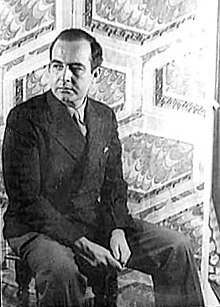| Adagio for Strings | |
|---|---|
| by Samuel Barber | |
 Samuel Barber, photographed by Carl Van Vechten, 1944 | |
| Key | B♭ minor |
| Year | 1936 |
| Based on | Barber's String Quartet |
| Duration | About 8 minutes |
| Scoring | String orchestra |
| Premiere | |
| Date | November 5, 1938[1] |
| Location | NBC Studio 8H, New York City |
| Conductor | Arturo Toscanini |
| Performers | NBC Symphony Orchestra |
| Audio sample | |
30-second sample of Adagio for Strings | |
Adagio for Strings is a work by Samuel Barber arranged for string orchestra from the second movement of his String Quartet, Op. 11.
Barber finished the arrangement in 1936, the same year that he wrote the quartet. It was performed for the first time on November 5, 1938, by Arturo Toscanini conducting the NBC Symphony Orchestra in a radio broadcast from NBC Studio 8H. Toscanini also conducted the piece on his South American tour with the NBC Symphony in 1940.
Its reception has generally been positive, with Alexander J. Morin writing that Adagio for Strings is "full of pathos and cathartic passion" and that it "rarely leaves a dry eye".[2] The music is the setting for Barber's 1967 choral arrangement of Agnus Dei. It has been called "America's semi-official music for mourning." Adagio for Strings has been featured in many TV and movie soundtracks.
- ^ Adagio for Strings by Cary O'Dell, Library of Congress, National Recording Registry
- ^ Cite error: The named reference
Third Ear?was invoked but never defined (see the help page).